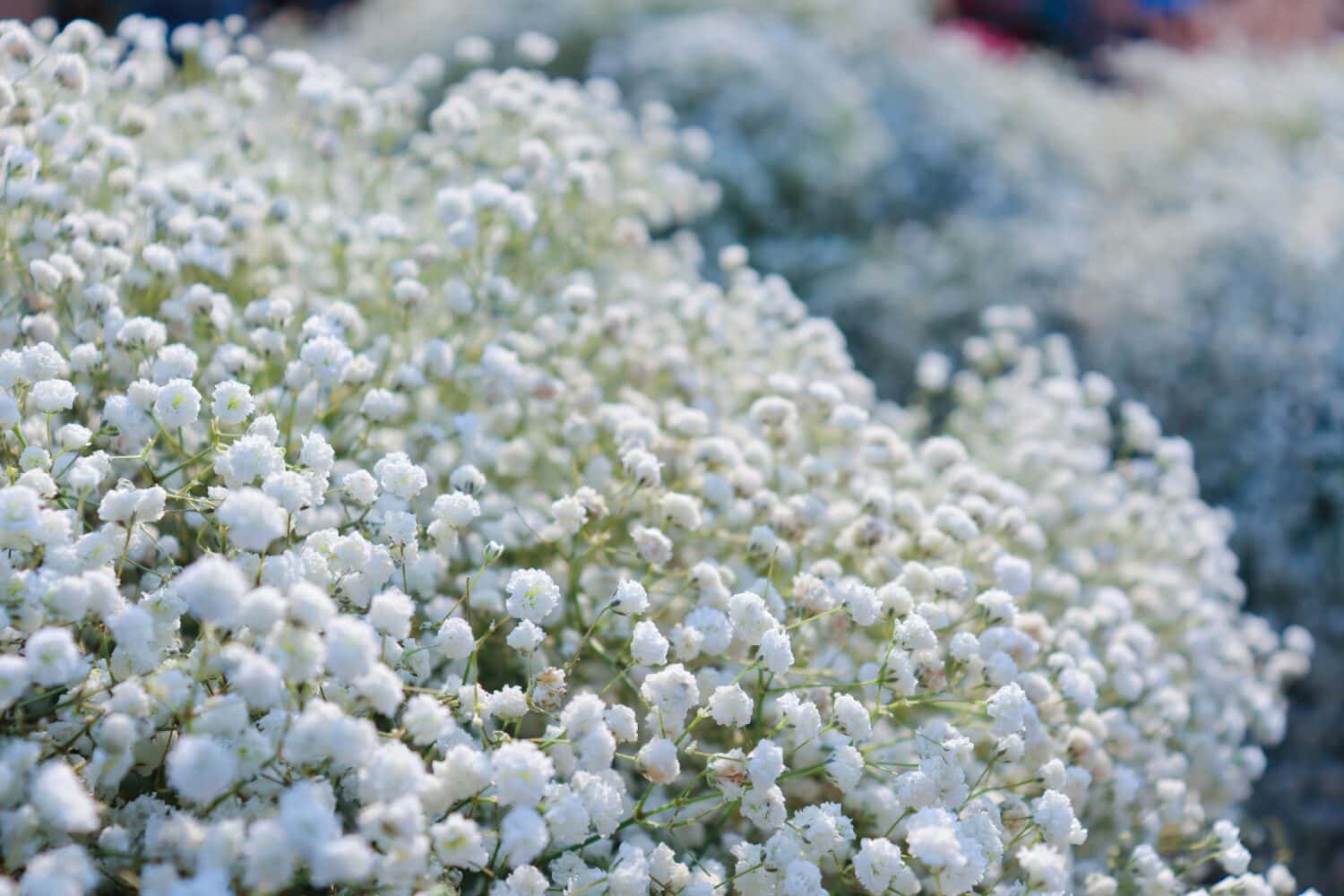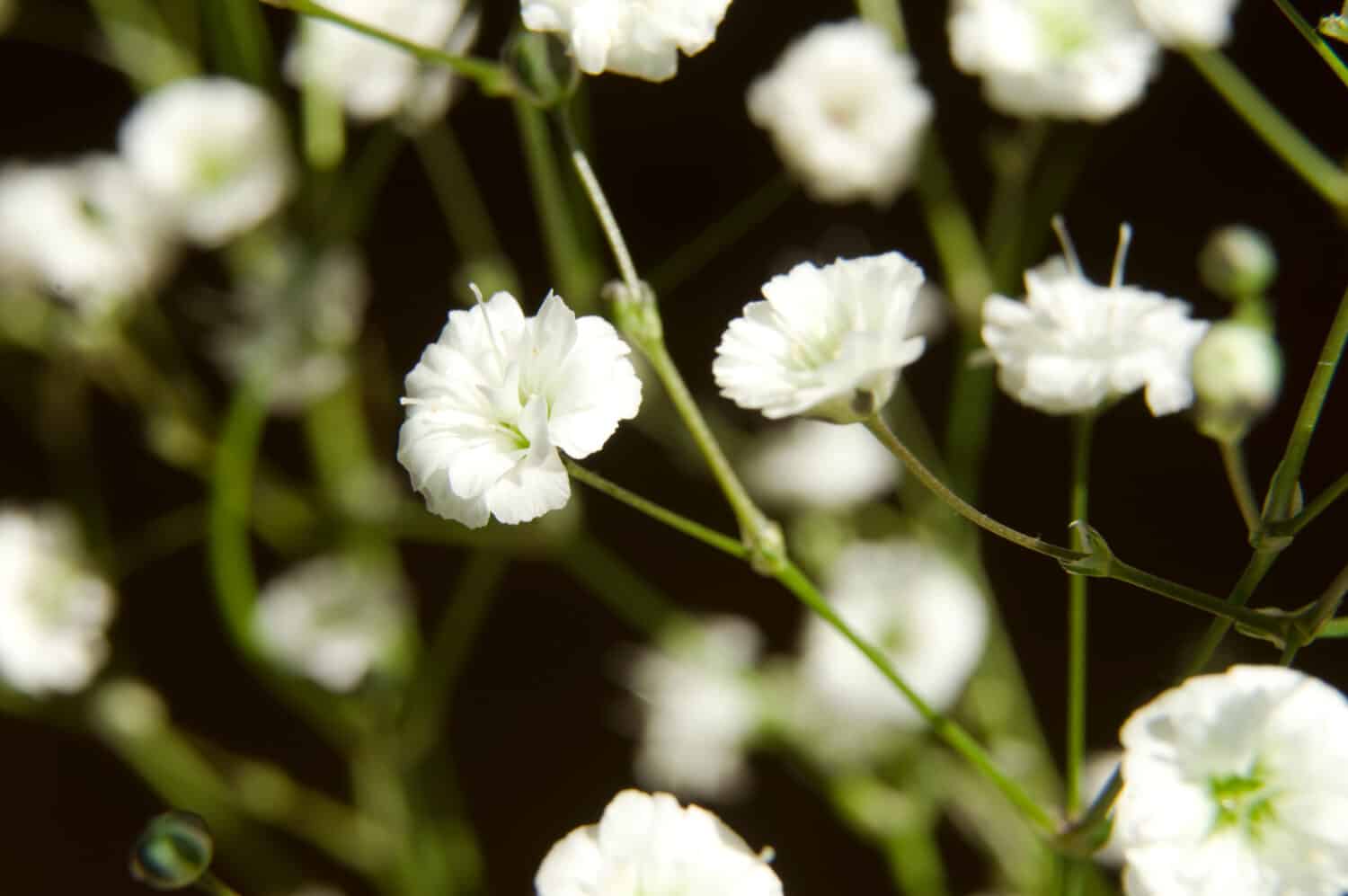
Baby’s breath (Gypsophila) is well-known in floral arrangements. However, they also look stunning growing in a garden. In addition, you can find more than 100 perennial and annual species in this genus. They also vary in appearance and growing patterns. Some creep and form a beautiful flowering ground cover, while others grow upwards and branch out slender stems with delicate flowers.
Baby’s breath leaves are blueish-green to gray-green and are narrow. When summer comes around, these plants have stunning, tiny five-petaled flowers that come in white or pink and last for a few weeks. These attractive flowers lure butterflies and other pollinators. Planting this in summer would be favorable when the danger of frost is over. Baby’s breath is a fast-growing plant considered invasive in North America. Furthermore, it has toxic qualities that can cause irritation to the skin and nose, dermatitis, and asthma in humans, as well as vomiting and diarrhea in pets. Lastly, baby’s breath needs full sun exposure and is native to Asia, Australia, Africa, and Europe.
Baby’s Breath Care
These plants require very little maintenance. They will take care of themselves if they are placed in a spot where they get a lot of natural light, and the soil has good drainage. Baby’s breath only needs watering during dry spells, and plant food once a year. However, when they fully mature, they might need some support in the form of a garden stake to prevent them from falling over, especially when they are flowering. Some people install these garden stakes when they plant the baby’s breath to avoid doing it later. Baby’s breath has been categorized as an invasive plant in the United States, particularly around the upper Great Lakes. Additionally, it is regarded as a noxious weed in Canada, Washington, and California.
Baby’s breath grows best when they get full sun, which means at least six hours of direct sunlight daily. However, they will allow a small amount of shade, especially in the heat of the day. Too much shade will lead to poor flowering. This plant will grow in almost any type of soil as long as it has good drainage. They do not like wet clay soil but do favor sandy soil. If you plan on planting Baby’s breath and think you do not have the correct soil, you should rather plant it in a raised bed or container. In addition, this plant likes a somewhat alkaline soil pH. Therefore, acidic soil can be sweetened with some garden lime.

Baby’s breath only needs watering during dry spells, and plant food once a year. However, when they fully mature, they might need some support in the form of a garden stake to prevent them from falling over, especially when they are flowering.
Image: Kullatida Papoowong, Shutterstock
©Kullatida Papoowong/Shutterstock.com
Water, Temperature, Humidity, and Fertilizer
This plant has a low water need and does well in dry soil. However, the soil should be kept moist when they are young to encourage growth. When they are mature, they will not need as much water, except if there is a period of extended drought. On the other hand, overwatering can result in root rot, which will eventually lead to the plant dying.
Baby’s breath is a relatively hardy plant and can tolerate varied temperatures. However, some variants have a better cold tolerance than others. Some of the variants prefer a dry climate rather than a humid one. Therefore, if you are growing this plant in an area with high humidity, it is even more important to have drainage so the plant is not exposed to constant moisture. Also, this plant needs minimal food, and too much fertilizer can result in floppy growth. Some compost can be worked into the soil every spring to get the best out of your plant.
Types of Baby’s Breath
Baby’s breath is known mainly from flower arrangements. However, there is more than one variant, but they are all beautiful in a garden or flower arrangement. They include the following:
- Gysophila panicultata “Bristol Fairy”: This variant can grow up to two or three feet wide and tall. It has white double blooms that are about ¼ inch wide.
- Gypsophila paniculate “Perfekta”: Growing up to three feet wide and tall, this variety is stunning in a garden setting. The flowers are similar to the “Bristol Fairy” variety. However, they are twice the size.
- Gypsophila panicultata “Compacta Plena”: Similar to the “Bristol Fairy” variety, this variant is considered compact as it only grows 15 to 18 inches wide and tall.
- Gypsophila panicultata “Viette’s Dwarf”: Another compact variant at 12 to 15 inches wide and tall, it will not need to be held up by a stake. This plant has double flowers that are pink and then steadily fade to white.
- Gypsophila elegans: This variant features large, open flowers compared to other Baby’s breath species. Also, it is an annual. However, it self-seeds and will pop back up in your garden yearly.
How to Grow Baby’s Breath From Seeds
Baby’s breath can be grown from seeds. You can begin by planting the seeds in a seed-starting mix kept indoors. This can be done six to eight weeks before planting them in spring. The soil should be kept moist but not too wet. If done correctly, seedlings should sprout in about 10 to 14 weeks. Then, once you are sure that the threat of frost is over, you can transplant them into a sunny area in your garden.
Baby’s breath is self-seeding, but you can help it along by sowing the seeds straight into the garden. They should be planted in a sunny, well-drained spot and covered with soil. Furthermore, the soil should be kept moist but not very wet. Lastly, the plants should be spaced around 12 inches apart.
Pruning Baby’s Breath
Pruning Baby’s breath is as easy as beheading the dead flowers to where the next spray comes out. Also, the plant will benefit from light pruning when the first flowering is over. This will assist in promoting another bloom and maintaining their shape. When the second bloom is finished, you can cut the stems to more or less one inch above the ground for winter. When spring arrives, it should start growing again.

Pruning Baby’s breath is as easy as beheading the dead flowers to where the next spray comes out. Also, the plant will benefit from light pruning when the first flowering is over.
Image: zzz555zzz, Shutterstock
©zzz555zzz/Shutterstock.com
Propagating Baby’s Breath
Propagating is relatively easy, which means breaking the plant up to make more than one. All you have to do is take cuttings from the baby’s breath and replant them. Start by cutting pieces about four to five inches from the healthy stems. Then, take all the leaves off the stems from a third of the branch at the bottom. After that, plant the cutting in a container with alkaline soil. Keep on misting the soil to keep it moist but not too wet. After four weeks, the cutting should have roots, and you can transplant it outside in the garden.
Common Pest & Plant Diseases
Baby’s breath does not have too many diseases and pests. However, they are susceptible to leafhoppers, Japanese beetles, rabbits, slugs, and aphids. Signs of one of these include holes in the leaves or discolored leaves. The best way to treat these is to use non-chemical methods such as soap or citrus. Furthermore, fungal infections and root rot resulting from overwatering are common diseases to look out for.
How to Get Baby’s Breath to Bloom
With its tiny delicate flowers, Baby’s breath will bloom in the late spring and then throughout the summer. The best way to promote further blooming is to follow the pruning steps and then cut it down just before winter. This should result in your Baby’s breath blooming every year.
Baby’s breath will last eight to ten days after being cut if placed in fresh water. Also, the flowers have a slight smell, which is not sweet but is appealing to some people. Some variants of Baby’s breath are perennial, and the plant will come up every year. Other variants are annuals and will self-seed, returning the following year.
What Does Baby’s Breath Symbolize?
Baby’s breath got its name from the fact that, in some cultures, it was given to new mothers after they gave birth for good luck. Additionally, it symbolizes new beginnings, hope, innocence, and purity. Therefore, it is traditionally used at baby showers and in wedding bouquets.
The photo featured at the top of this post is © outlander1746/Shutterstock.com
Thank you for reading! Have some feedback for us? Contact the AZ Animals editorial team.







